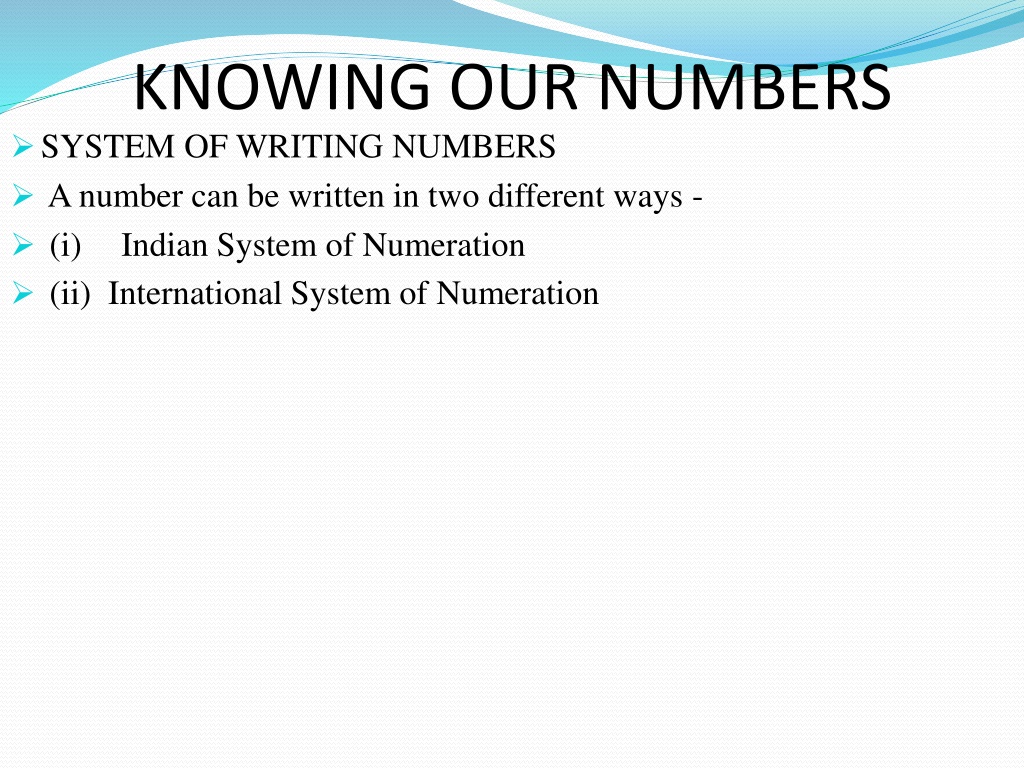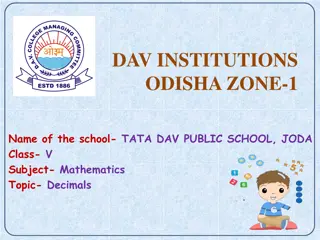Understanding Numeration Systems in Indian and International Number Writing
Explore the differences between Indian and International Numeration Systems used for writing numbers. Indian system uses ones, tens, hundreds, thousands, lakhs, ten lakhs, and crores with commas to mark each digit grouping. International system includes ones, tens, hundreds, thousands, and millions. Learn to convert large numbers between these two systems and practice inserting commas in both for clarity.
Download Presentation

Please find below an Image/Link to download the presentation.
The content on the website is provided AS IS for your information and personal use only. It may not be sold, licensed, or shared on other websites without obtaining consent from the author. Download presentation by click this link. If you encounter any issues during the download, it is possible that the publisher has removed the file from their server.
E N D
Presentation Transcript
KNOWING OUR NUMBERS SYSTEM OF WRITING NUMBERS A number can be written in two different ways - (i) Indian System of Numeration (ii) International System of Numeration
KNOWING OUR NUMBERS INDIAN SYSTEM OF WRITING NUMBERS In our Indian System of Numeration we use ones, tens, hundreds, thousands , ten thousands, lakhs, ten lahs and then crores. Commas are used to mark thousands, lakhs and crores. The first comma comes after hundreds place (three digit from the right) and marks thousands. The second comma comes two digits later (five digits from the right). It comes after ten thousands place and marks lakh. The third comma comes after another two digits (seven digits from the right). It comes after ten lakh place and marks crore. For example - 5, 08, 01, 592 and 3, 32, 40, 781
KNOWING OUR NUMBERS SYSTEM OF WRITING NUMBERS- INTERNATIONAL SYSTEM OF NUMERATION INTERNATIONAL SYSTEM OF NUMERATION
KNOWING OUR NUMBERS INTERNATIONAL SYSTEM OF NUMERATION In the International System of Numeration, as it is being used we have ones, tens, hundreds, thousands and then millions. One million is a thousand thousands. Commas are used to mark thousands and millions. It comes after every three digits from the right. The first comma marks thousands and the next comma marks millions. For example, the number 50,801,592 is read in the International System as fifty million eight hundred one thousand five hundred ninety two. In the Indian System, it is five crore eight lakh one thousand five hundred ninety two. (5,08,01,592 )
KNOWING OUR NUMBERS International System of Numeration How many lakhs make a million? How many millions make a crore? Take three large numbers. Express them in both Indian and International Numeration systems. Interesting fact : To express numbers larger than a million, a billion is used in the International System of Numeration: 1 billion = 1000 million.
KNOWING OUR NUMBERS Insert commas and represent the following in the Indian as well as the International system of numeration : a. 2202312 b. 71809020 c. 445566889 d. 300304628 1.
KNOWING OUR NUMBERS 2. Insert commas suitably and write the names according to Indian System of Numeration : 87595762 (c) 99900046 3. Insert commas suitably and write the names according to International System of Numeration : (a) 78921092 (b) 7452283 (c) 99985102 (d) 48049831 (b) 8546283 (d) 98432701
KNOWING OUR NUMBERS Write the numerals for the following number names : Twenty-two lakh four thousand two hundred sixteen. Five crore twenty- five lakh six thousand four hundred three. Three hundred two million seven thousand three hundred seventeen. Six hundred six million six hundred six. 3. a. b. c. d.
KNOWING OUR NUMBERS Write the number name for the following numerals : a. 6,73,42,817 b. 24,000,010 c. 235,010,816 4.
KNOWING OUR NUMBERS 5. Place commas correctly and write the numerals: (a) Seventy three lakh seventy five thousand three hundred seven. (b) Nine crore five lakh forty one. (c) Seven crore fifty two lakh twenty one thousand three hundred two. (d) Fifty eight million four hundred twenty three thousand two hundred two. (e) Twenty three lakh thirty thousand ten.























